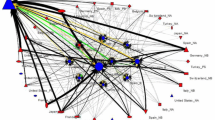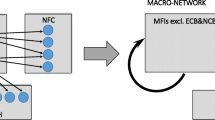Abstract
The financial sector is a critical component of any economic system, as it delivers key qualitative asset transformation services in terms of liquidity, maturity and volume. Although these functions could in principle be carried out separately by specialized actors, in the end it is their systemic co-evolution that determines how the aggregate economy performs and withstands disruptions. In this paper we argue that a functional perspective on financial intermediation can be usefully employed to investigate the functioning of financial networks. We do this in two steps. First, we use previously unreleased data to show that focusing on the economic functions performed over time by the different institutions exchanging funds in an interbank market can be informative, even if the underlying topological structure of their relations remains constant. Second, a set of alternative artificial histories are generated and stress-tested by using real data as a calibration base, with the aim of performing counterfactual welfare comparisons among different topological structures.












Similar content being viewed by others
Notes
Within the Italian cooperative credit system, comprising 364 intermediaries at the end of 2015, it is possible to distinguish between rural banks, cooperative credit banks and Raiffeisen banks. All of them are mutual not-for-profit cooperatives, operating with a small number of branches (the average for the system in 2015 was 8) on local markets. In what follows we use the expression “cooperative credit banks” as a shortcut to comprise them all.
An exception is represented by Aguiar et al. (2014).
The Italian law admits several alternative governance models for banks. In addition to cooperative credit banks, bank intermediaries can be chartered as Banche Popolari (cooperative banks with somehow lighter constraints on the fraction of loans deliverable to non-member borrowers and the distribution of dividends, and the possibility to go public), Casse di Risparmio (Savings and Loan associations, typically coming with the form of joint stock companies) and standard shareholder banks. In what follows we will group them all under the heading “shareholder banks”.
Non-overnight flows comprise all transactions with maturities ranging from 2 days to 36 months.
Silva et al. (2016) show that also the bank-level efficiency is affected by the structure of the interconnections linking financial intermediaries.
If the hub is a deficit bank and the periphery is composed by one half of deficit and one half of surplus banks, 50% of the links are misbehaved. A similar result holds if the hub is a surplus bank.
More in detail, we assumed that CC and BoI could not be directly shocked as they simply do not accept deposits from the general public.
Of course, there is no guarantee that a decentralized system would be able to actually provide this level of liquidity. We do not investigate this. Given this assumption, our analysis thus provides a best-case scenario for a decentralized system.
References
Aguiar A, Bookstaber RM, Wipf T (2014) A map of funding durability and risk. Off Financ Res Work Pap Ser 14(03). https://doi.org/10.2139/ssrn.2475041
Allen F, Babus A (2009) Networks in finance. In: Kleindorfer P, Wind Y, Gunther R (eds) The network challenge: strategy, profit, and risk in an interlinked world. Wharton School Publishing, Upper Saddle River, NJ, pp 367–382
Allen F, Gale D (2000) Financial contagion. J Political Econ 108(1):1–33
Anand K, Craig B, von Peter G (2015) Filling in the blanks: network structure and interbank contagion. Quant Financ 15(4):625–636
Anand K, Gai P, Kapadia S, Brennan S, Willison M (2013) A network model of financial system resilience. J Econ Behav Organ 85:219–235
Babus A (2016) The formation of financial networks. RAND J Econ 47(2):239–272
Bala V, Goyal S (2000) A noncooperative model of network formation. Econometrica 68(5):1181–1229
Bargigli L, di Iasio G, Infante L, Lillo F, Pierobon F (2015) The multiplex structure of interbank networks. Quant Financ 15(4):673–691
Battiston S, Delli Gatti D, Gallegati M, Greenwald B, Stiglitz JE (2012) Default cascades: when does risk diversification increase stability? J Financ Stab 8(3):138–149
Bhattacharya S, Thakor A (1993) Contemporary banking theory. J Financ Intermed 3(1):2–50
Boss M, Elsinger H, Summer M, Thurner S (2004) Network topology of the interbank market. Quant Financ 4(6):677–684
Castiglionesi F, Eboli M (2015) Liquidity flows in interbank networks, pp 1–57. Preprint available at https://sites.google.com/site/fabiocasti2310/research-1
Chinazzi M, Fagiolo G (2015) Systemic risk, contagion, and financial networks: a survey. https://doi.org/10.2139/ssrn.2243504
Craig BR, Fecht F, Tümer-Alkan G (2015) The role of interbank relationships and liquidity needs. J Bank Financ 53:99–111
Craig B, Von Peter G (2014) Interbank tiering and money center banks. J Financ Intermed 23(3):322–347
ECB (2012) The interplay of financial intermediaries and its impact on monetary analysis. European Central Bank Monthly Bulletin 1: 59–73
Feri F (2007) Network formation with endogenous decay. Technical report, Faculty of economics and statistics, University of Innsbruck
Finger K, Fricke D, Lux T (2013) Network analysis of the e-mid overnight money market: the informational value of different aggregation levels for intrinsic dynamic processes. Comput Manag Sci 10(2–3):187–211
Fricke D, Lux T (2015) Core-periphery structure in the overnight money market: evidence from the e-mid trading platform. Comput Econ 45(3):359–395
Gaffeo E, Molinari M (2015) Interbank contagion and resolution procedures: inspecting the mechanism. Quant Financ 15(4):637–652
Gaffeo E, Molinari M (2016) Macroprudential consolidation policy in interbank networks. J Evolut Econ 26(1):77–99
Gai P, Haldane A, Kapadia S (2011) Complexity, concentration and contagion. J Monet Econ 58(5):453–470
Gai P, Kapadia S (2010) Contagion in financial networks. Proc R Soc Lond A 46(2120):2401–2423
Georg CP (2013) The effect of the interbank network structure on contagion and common shocks. J Bank Financ 37(7):2216–2228
Gorton G, Winton A (2003) Financial intermediation. In: Constantinides G, Harris M, Stulz RM (eds) Handbook of the Economics of Finance, chapter 08, Part 1, vol 1, 1st edn. Elsevier, Amsterdam, pp 431–552
Hatzopoulos V, Iori G, Mantegna RN, Miccichè S, Tumminello M (2015) Quantifying preferential trading in the e-mid interbank market. Quant Financ 15(4):693–710
Hojman DA, Szeidl A (2008) Core and periphery in networks. J Econ Theory 139(1):295–309
Iori G, De Masi G, Precup OV, Gabbi G, Caldarelli G (2008) A network analysis of the italian overnight money market. J Econ Dyn Control 32(1):259–278
Iori G, Jafarey S, Padilla F (2006) Systemic risk on the interbank market. J Econ Behav Organ 61(4):525–542
Krause A, Giansante S (2012) Interbank lending and the spread of bank failures: a network model of systemic risk. J Econ Behav Organ 83(3):583–608
Lee SH (2013) Systemic liquidity shortages and interbank network structures. J Financ Stab 9(1):1–12
Mancini L, Ranaldo A, Wrampelmeyer J (2016) The euro interbank repo market. Rev Financ Stud 29(7):1747–1779
Manna M, Iazzetta C (2009) The topology of the interbank market: developments in italy since 1990. Working Paper 711, Bank of Italy, Economic Research and International Relations Area
Martinez-Jaramillo S, Alexandrova-Kabadjova B, Bravo-Benitez B, Solórzano-Margain JP (2014) An empirical study of the mexican banking system’s network and its implications for systemic risk. J Econ Dyn Control 40:242–265
Merton RC (1992) Financial innovation and economic performance. J Appl Corp Financ 4(4):12–22
Merton RC (1995) A functional perspective of financial intermediation. Financ Manag 24:23–41
Merton RC, Bodie Z (1995) A conceptual framework for analyzing the financial system. In: Crame et al (eds) The global financial system: a functional perspective, Harvard Business School Press, Boston, MA, pp 3–31
Merton RC, Bodie Z (2005) Design of financial systems: towards a syntheses of function and structure. J Invest Manag 3(1):6
Neveu AR (2016) A survey of network-based analysis and systemic risk measurement. J Econ Interact Coord. https://doi.org/10.1007/s11403-016-0182-z
Nier E, Yang J, Yorulmazer T, Alentorn A (2007) Network models and financial stability. J Econ Dyn Control 31(6):2033–2060
Shin HS (2010) Risk and liquidity. Oxford University Press, Oxford
Silva TC, Guerra SM, Tabak BM, de Castro Miranda RC (2016) Financial networks, bank efficiency and risk-taking. J Financ Stab 25:247–257
Soramäki K, Bech ML, Arnold J, Glass RJ, Beyeler WE (2007) The topology of interbank payment flows. Phys A Stat Mech Appl 379(1):317–333
Upper C (2011) Simulation methods to assess the danger of contagion in interbank markets. J Financ Stab 7(3):111–125
Acknowledgements
This version of the paper has greatly benefited from the very constructive comments of two anonymous referees. We are grateful to Cassa Centrale Banca, in particular to Thomas Franchini, for the data used in this study, and to Seung Hwan Lee for having shared with us his codes. We also wish to thank for helpful discussions and suggestions Leonardo Bargigli, Pietro Battiston, Michele Catalano, Giovanni Cerulli, Giorgio Di Giorgio, Matteo Falagiarda, Giovanni Ferri, Guido Germano, Simone Giansante, Roberto Tamborini and the audiences at the ECB - Monetary Analysis Division (Frankfurt am Main, Germany), the 25th International Rome Conference on Money, Banking and Finance - Roma Tre University, the 57th Annual Conference of the Italian Economic Association, Bocconi University (Milano- Italy), the IWCEE15 - International Workshop on Computational Economics and Econometrics, Rome (Italy), the 20th WEHIA Workshop - SKEMA Business School, Sophia Antipolis (France) and the 5th International Workshop on Cooperative Finance and Sustainable Development, University of Trento (Italy). Massimo Molinari gratefully acknowledges the financial support of Fondazione Caritro. Part of the research undertaken for this paper was done when Massimo Molinari was at Sapienza University of Rome and supported by the funding grant 278/2016 from the same institution. The opinions expressed herein are those of the authors and do not necessarily reflect the views of the Bank of Italy or the Eurosystem.
Author information
Authors and Affiliations
Corresponding author
Rights and permissions
About this article
Cite this article
Gaffeo, E., Molinari, M. A functional perspective on financial networks. J Econ Interact Coord 13, 51–79 (2018). https://doi.org/10.1007/s11403-017-0210-7
Received:
Accepted:
Published:
Issue Date:
DOI: https://doi.org/10.1007/s11403-017-0210-7




